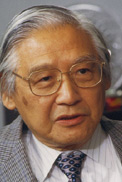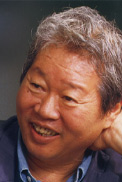  |
 |
 |
How Far Will Brain Science Research Advance and What Will It Bring?
The
Brain Science Institute (BSI) of RIKEN was established in October 1997; this year
we are celebrating our third anniversary. On what concepts was the BSI founded,
and how much progress has been made? The 21st century is considered to be the
"century of the brain;" how far can brain science advance in this time?
Mr. Takashi Tachibana, a journalist who has conducted numerous interviews in the
field of brain science, and Dr. Masao Ito, Director of the BSI, discuss the current
status and perspectives of brain science.
Three
years since establishing the research center; Researchers at the 'golden age'
of thirty-three are supporting the BSI
Tachibana:
It has been exactly three years since the founding of the BSI. When I interviewed
you at that time, you were still conducting research at the Frontier Research
System (*1)
Ito: Initially, I started three brain-science-related research
laboratories in the Frontier Research System. Over the next ten years, the kinds
of research diversified and the number of laboratories increased to ten. Three
years ago, we added ten more research groups and the BSI was established. We have
since expanded to include 37 research laboratories.
Tachibana: Three years ago, when you wished to establish the BSI, what
kind of institute were you thinking of creating?
Ito: I had in mind a center
where it would be possible to deal with issues which

Masao
Ito
Director of the BSI. Born in 1928. He graduated from the Faculty of Medicine at
the University of Tokyo with his M.D. After graduation, he studied at a national
university in Australia beginning in 1959 under Professor John Eccles, who received
the Nobel Prize for his research on synapses. Dr. Ito is a world authority on
the cerebellum. After working as a professor at the University of Tokyo, he has
been in his present position since 1997. |
had
not previously been addressed.
Tachibana: I see. Could you tell us what you mean more specifically?
Ito: One issue was the fusing of disciplines. The many advances in all
the classical disciplines of science over the last 50 years has made "Brain
Science" completely different from what we usually think of as being a "Science".
While we still seek to find the singular element or fact of nature, it has become
clear that the working of the brain involves a highly complex interaction of a
great many elements. The sciences to date, has never attempted to study and understand
a system with such complexity. If we wish to study the brain, we must adopt an
approach which takes various directions with the knowledge that the study is massively
interdisciplinary. Such research is not possible within our current university
structures. This is the main reason why we established this institute. Another
important reason is internationalization or globalization. When I established
the plans for this institute, a major policy item was that the research staff
be comprised of 30% foreign researchers. In the last 3 years we have almost achieved
this goal with the present number of foreign researchers at 20% among them, six
are laboratory heads in a total of 37 laboratory heads.
Tachibana: I feel that the atmosphere of internationalization affects the
entire research institute. I hear that conferences have been carried out in English.
Ito: Today, the universal language of Neuroscience is English. In order
to strengthen our use of English, all of our seminars and meetings are held in
English. I think this has been effective as I can often hear young Japanese researchers
talking with each other in English.
Tachibana: Disciplinary fusion and internationalization. Are there any
other issues that you would like to mention?
Ito: Yes, the youth of researchers. The average age of our researchers
is 33. In my opinion, this is the age when most individuals are at their most
"clear headed", it is the "golden age" of a researcher. The
most significant secret to the success of the American research system is that
individuals who have completed postdoctoral(*2) training, equivalent to that of
research staff in the Japanese education system, are given a significant degree
of freedom of action. When these individuals have completed their postdoctoral
training and are accepted as assistant professors, they are able to apply to the
National Institutes of Health (NIH) for a research grant. If they receive a research
grant, they can go on to hire postdoctoral fellows and launch their own research
.
 
|
|
 |
| The
concept of disciplinary fusion |

Takashi
Tachibana
A nonfiction writer. Born in 1940. He graduated from the Department of French
Literature at the University of Tokyo in 1964. He worked for a while at Bungei
Shunju Co. and then resigned from the company in 1966 and entered the Department
of Philosophy at the University of Tokyo. While studying at the University, his
career as a journalistic critic began. His publications include “Master the Brain,"
"The Brain and the Big Bang," "Universe, Earth, Life, Brain,"
"Science Millenium"and "Reclamation of Human Bodies."
|
Tachibana: From
a global perspective, it is very unique that you included the discipline of creating
the brain.
Ito: The three divisions of the institute, Understanding the brain, Protecting
the brain and Creating the brain are not "disciplines" in the usual
sense because they each are comprised of individuals trained in diverse disciplines.
These divisions may be more representative of what brain science is really about,
a combining of disciplines to create a new entity. American researchers have been
slightly surprised at this. Someone wrote that they had never thought of the Japanese
unifying computer science, which is the field of creation, and biology. He warned
us, "You can’t combine two such organizations, soon they will start to fight!"
(laughs).
Tachibana: This uniqueness is highly appreciated internationally; foreign
research institutes appear to be pursuing the initiatives taken by the brain science
research of Japan. Your concept is very unusual in the field of brain science,
which has traditionally been a very orthodox field. When did you begin to develop
the concept of combining the three elements, understanding the brain, protecting
the brain and creating the brain?
Ito: To be honest with you, thinking back, I was in an excellent academic
environment in the 1960s at the University of Tokyo. The university was a much
more general university as the exchange among faculties was more active than it
is now. Hidetoshi Takahashi, from the Department of Physics, Faculty of Science,
Toshihiko Tokizane, who founded the brain research facility in the Faculty of
Medicine, and Jin-ichi Nagumo, who studied bionics in the Faculty of Engineering,
though unfortunately, all of them have since passed away, together with young
researchers, conducted research in groups and held joint lectures. Although the
professional backgrounds of the involved individuals varied a great deal, they
were all interested in the same thing; however, their approaches and conceptions
were completely different. As a result of their influence, I lost my attitude
of resistance to unification.
Tachibana: Since you’ve hired individuals in the institute whose professional
backgrounds and research methodologies vary widely, I hope that the unification
is successful. I also look forward to hearing of the new discoveries and ideas
that will come about as well as the new power which is generated through the combination
of new knowledge .
From
layer-by-layer (hierarchical research) to system-oriented research
Tachibana:
When I look at the profiles of the research team members in each research field,
I can tell that you are planning to study all the aspects of the brain. For example,
in the field of understanding the brain, the current areas of study are layered
and include the molecular level, the cellular level and the circuit level, in
addition to the system level. These arrangements seem to be a realization of your
highest expectations.

magnified scene by clicking image
The photograph on the left is of zebra fish. The two photographs on the right show a motor neuron of the metencephalon of a transgenic zebra fish embryo which expresses fluorescent protein derived from light-emitting jellyfish. The neural cell body and its axon twinkle with a green color. (Provided by Dr. Hitoshi Okamoto, Head of the Laboratory for Developmental Gene Regulation) |
Ito: It has
been three years since the establishment of the first research groups, and the
layer-oriented hierarchical divisions have become substantially diffused; one
cannot remain in a single field and say "I study cells only, and you study
circuits." All things are connected. Therefore, we almost take the approach,
"I study the sensory systems, motion systems or cognition system"; each
research discipline tends to be identified in terms of systems. For instance,
in the case of the study of topics related to the olfactory system, we mobilize
all possible technologies from molecular biology, electrophysiology and engineering-type
optical measurements. While the hierarchical approach to research is still the
mainstay of science, the very rapid changes occurring today with the addition
of new knowledge at every level, has forced changes in the ways of doing research.
Therefore the institute has adopted the policy of evaluating all of the research
programs after 5 years of activity. Established researchers who are working at
the cutting edges of their fields are invited from throughout the world to form
the evaluation teams. With such access to outside opinion, the quality of the
work in the institute will be at the forefront of international Brain Science.
|
Development
of research technology is important
Tachibana: I was
impressed with the organizational chart. You even have an Advanced Technology
Development Center(*3)
Ito: Thank you for the compliment. I am proud of it (laughs).
Tachibana: You have done well. I feel that the weakness of research in
Japan is related to this point. The issue of research methodology is extremely
important. Whether various technologies for research are developed or not creates
significant differences in terms of the research achievements. In this sense too,
the existence of the Advanced Technology Development Center impressed me and I
am moved.
Ito: As I pointed out before, our knowledge in all disciplines involved
in the brain sciences is expanding very rapidly. An important part of these advances
stem from the incorporation of new technologies into the strategies of brain science
research. By making the Advanced Technology Development Center an integral part
of the Brain Science Institute, I think we have made an important move in the
direction of modernizing research in the brain.
Tachibana: I understand that you are developing some tremendously significant
technology at this research center. You have already established a new technology
which induces the expression of any gene in the manner you decide. I am surprised
that you are going to disclose the details of the method after patent application
and research paper publication. This is wonderful; if you disclose this, the entire
world will be excited.
Ito: Yes, this project concerns a study on the Zebra fish. These fish have
very transparent skulls which allows using various optical methods to observe
what is going on in the working brain without opening the skull.
Tachibana: The world of genes is the same regardless of whether it is humans,
fish or mice. The technology which enables us to "express" desired patterns
at a desired location and a desired time is a technology that all scientists have
dreamed of.
Ito: We have also used these advances in the control of gene expression
to make neurons express a fluorescent molecule in specific neuron types which
change their fluorescence with changes in particular cellular constituents. In
addition, we have attached a fluorescent molecule to a gene which expresses in
a particular neuron. The attached
molecule fluoresces when the gene is expressed which allows us to see when the
gene is being expressed in that
neuron.
|
|
| 
|
 |
 |
|
|



